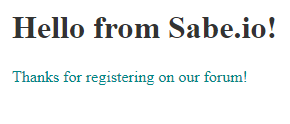Table of Contents
Sending mail is a very common thing to do for a dynamic application or website. You want to inform your users of critical events like a successful sign up, major updates or changes, a successful purchase, and any changes in status of their accounts. Sending mail in PHP is done with the mail() function, which both builds and sends the email from your server.
Here is the basic syntax for the function:
PHPmail(destination, subject, message, headers, parameters);
Here is the explanations for each parameter:
- destination: The recipient's email address to send the email to.
- subject: The subject line of the email.
- message: The content of the email.
- headers: Additional headers like "From", "Cc", and "Bcc".
- parameters: Any additional parameters.
Sending Plain Text Emails
The simplest email to send is a plain text email. That is, the body of the email is just normal text. Here's an example of sending a plain text email:
PHP<?php
$destination = "[email protected]";
$subject = "Hello there, from Sabe";
$message = "Hello, thanks for registering on our forum!";
$from = "[email protected]";
$headers = "From: $from";
mail($destination, $subject, $message, $headers);
?>
That's all you need to do to send a plain text email. An important thing to note is that the mail() function will return a boolean indicating if sending the email was successful or not. That means you can run different code if it fails, like this:
PHP<?php
$destination = "[email protected]";
$subject = "Hello there, from Sabe";
$message = "Hello, thanks for registering on our forum!";
$from = "[email protected]";
$headers = "From: $from";
$success = mail($destination, $subject, $message, $headers);
if ($success) {
// sending was successful
} else {
// sending was not successful
}
?>
Sending HTML Emails
Sending HTML emails requires a bit more work to ensure it renders properly. To accomplish this, we simply need to pass additional headers with our emails so that the user's email client knows to render the email as an HTML page.
PHP<?php
$destination = "[email protected]";
$subject = "Hello there, from Sabe";
$from = "[email protected]";
$headers = 'MIME-Version: 1.0' . "\r\n";
$headers .= 'Content-type: text/html; charset=iso-8859-1' . "\r\n";
$headers .= 'From: ' . $from . "\r\n";
$message = '<html>';
$message .= '<body>';
$message .= '<h1 style="color:#333;">Hello from Sabe.io!</h1>';
$message .= '<p style="color:#088;">Thanks for registering on our forum!</p>';
$message .= '</body>';
$message .= '</html>';
mail($destination, $subject, $message, $headers);
?>
Your HTML email would then look something like this:
 An example of an HTML email.
An example of an HTML email.
Emails are a powerful way to connect with your users and keep them up-to-date with the most important information. Now you know how to send both plain text and HTML emails dynamically with your server using PHP!
 How to Install Node on Windows, macOS and Linux
How to Install Node on Windows, macOS and Linux Getting Started with Svelte
Getting Started with Svelte Create an RSS Reader in Node
Create an RSS Reader in Node Getting Started with Electron
Getting Started with Electron How to Serve Static Files with Nginx and Docker
How to Serve Static Files with Nginx and Docker How to deploy a .NET app using Docker
How to deploy a .NET app using Docker Best Visual Studio Code Extensions for 2022
Best Visual Studio Code Extensions for 2022 How to deploy a Node app using Docker
How to deploy a Node app using Docker Getting Started with Sass
Getting Started with Sass Learn how to use v-model with a custom Vue component
Learn how to use v-model with a custom Vue component Learn how to build a Slack Bot using Node.js
Learn how to build a Slack Bot using Node.js Setting Up a Local Web Server using Node.js
Setting Up a Local Web Server using Node.js
